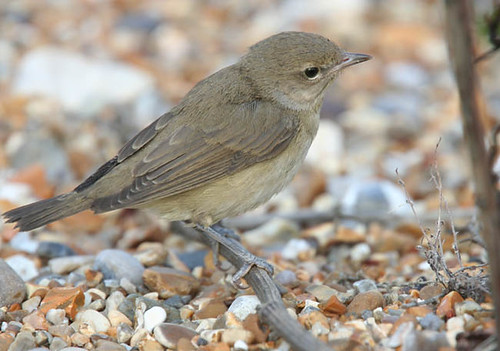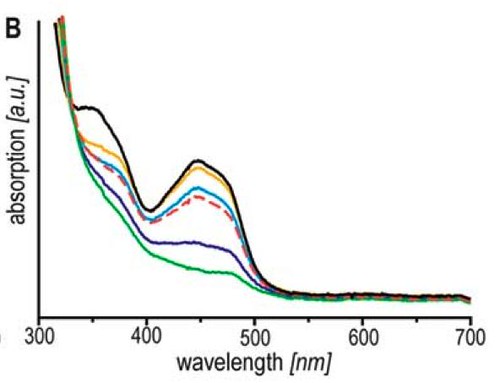tags: researchblogging.org, birds, migration, cryptochrome, blue light, garden warbler, Sylvia borin, magnetic compass, avian cryptochrome 1a, ornithology
Garden Warbler, Sylvia borin (Boddaert, 1783)
Blakeney Point, 16th September 2006.
Image: Matthew Rodgers [larger image].
Every year, millions of birds migrate to their breeding grounds and then back to their wintering grounds again. These birds' journies cover anywhere between several hundred to many thousands of miles, even when the skies are cloudy or dark. How do birds unerringly find their way to their destinations? Thanks to recent research on this topic, part of the answer might be the presence of a special protein, cryptochrome, in avian eyes that is sensitive to blue light.
Because it had previously been shown that birds align themselves to their normal migration routes in blue light but cannot do so in yellow or red light, this intriguing connection was followed up and revealed the presence of cryptochrome in avian eyes.
Cryptochromes act as blue light photoreceptors and are part of a group of proteins known as flavoproteins. Flavoproteins contain either a flavin adenine dinucleotide (FAD) or flavin mononucleotide (FMN). There are two cryptochromes, each of which is encoded by one of two separate but similar genes: CRY1 and CRY2. Interestingly, cryptochromes are nearly ubiquitous in the living world; they have also been found in all plants, in corals, insects and in mammals where they play a crucial role in light-based responses. In mammals, for example, cryptochromes are involved in the establishment and maintenance of circadian rhythms.
But what does perceiving blue light have to do with migration? Is this photosensitive protein capable of providing birds with the necessary information so they can migrate between their breeding and wintering grounds? Despite the fact that cryptochromes were found in the eyes of a few migratory birds, it was not clear whether these proteins were functioning as the birds' main magnetoreceptor, nor was it certain that the birds were sensing the earth's magnetic compass primarily, or solely, with their eyes.
To further investigate this possibility, a group of European scientists, led by Henrik Mouritsen, from the University of Oldenburg in Germany, cloned the CRY gene from migratory garden warblers, Sylvia borin so they could produce enough of it in purified form so they could work with.
After cloning the CRY gene, they identified the both the complete cryptochrome protein and the photolyase-homology-region (PHR) of Cry1 (gwCry1-PHR), and investigated both separately, beginning by identifying the both the gene sequence data (not shown) and the protein by producing each protein in in vitro cell cultures. (figure 2, below);
Figure 2. SDS-PAGE of recombinantly expressed garden warbler cryptochrome (shown for gwCry1a protein). A Coomassie stained SDS gel, and B Western-blot (with a-Cry1 antiserum from immunised goat), both showing identical fractions of the IMAC purification process. gwCry1a (628 aa) is present as a distinct band at .62 kDa in both the coomassie stained SDS gel and on the Western-blot (arrow at right). [doi:10.1371/journal.pone.0001106]
After they were certain they had produced the correct protein in cell cultures, the team went on to examine the absorption spectra of the purified gwCry1-PHR protein in all of its biologically relevant states; fully reduced (FADH2 or FADH2), semiquinone radical (FADN2 or FADHN), and fully oxidized (FAD), as shown in Figure 3A (below);
Figure 3. Optical spectroscopy of cryptochrome holoprotein from migratory garden warblers. A gwCry1-PHR, illumination time: 0 s (black), 40 s (yellow), 80 s (orange), 130 s (light blue), 190 s (blue) and 340 s (green), respectively. [doi:10.1371/journal.pone.0001106]
To identify the complete protein's characteristics, they then subjected gwCry1a in all of its biologically relevant states to the same experiments (Figure 3B, below);
Figure 3. Optical spectroscopy of cryptochrome holoprotein from migratory garden warblers. B gwCry1a, illumination time: 0 s (black), 90 s (yellow), 150 s (orange), 240 s (light blue), 360 s (blue) and 540 s (green), respectively. [doi:10.1371/journal.pone.0001106]
These light absorption experiments revealed that that these flavoproteins are indeed excited by light in the blue spectral range. This is exciting because, based on behavioral experiments, we know that migratory birds orient themselves to the Earth's magnetic field using blue light. Not only that, but when exposed to a brief flash of light, the proteins form radicals that survive five orders of magnitude longer than theoretically required to be involved in generating magnetic field effects. As a result, these biophysical characteristics suggest that gwCry1a is ideally suited to be the primary magnetic compass receptor in migratory birds.
Sources
"Chemical Magnetoreception: Bird Cryptochrome 1a Is Excited by Blue Light and Forms Long-Lived Radical-Pairs" by Miriam Liedvogel, Kiminori Maeda, Kevin Henbest, Erik Schleicher, Thomas Simon, Christiane R. Timmel, P. J. Hore, Henrik Mouritsen. PLoS ONE 2(10): e1106 (October 2007). [doi:10.1371/journal.pone.0001106].
Also;
"A model for photoreceptor-based magnetoreception in birds" by Thorsten Ritz, Salih Adem, and Klaus Schulten. Biophysical Journal, 78:707-718 (2000). [free PDF].
"Light-responsive cryptochromes from a simple multicellular animal, the coral acropora millepora" by Levy, O.; Appelbaum L., Leggat W., Gothlif Y., Hayward D.C., Miller D.J., Hoegh-Guldberg O. Science 318 (5849): 467-470 | doi:10.1126/science.1145432 [PDF]. .
"Cryptochromes: Blue light receptors for plants and animals" by Cashmore, A.R., Jarillo, J.A., Wu, Y.-L., and Liu, D. Science 284, 760-765 (1999) [free PDF].
"A Component of the Cryptochrome Blue Light Signaling Pathway" by Nancy A. Eckardt The Plant Cell, Vol. 15, 1051-1052 (2003) [free PDF].





Interesting. Another mechanism important in migration uses the Earth's weak magnetic field to activate tiny particles of iron oxide in bird's beaks. Details here: http://www.nature.com/news/2004/041122/full/news041122-7.html
That's very interesting, but a more interesting question to me is how juvenile birds, who have never been to the wintering grounds, are able to go there before their parents. That is the case in at least some birds, peregrine falcons for certain, and many, if not most others, IIRC.
I was on Assateague Island one October some years ago, and thought I was seeing Merlins. They were really first-year Peregrines, which I thought were smaller than they really were because I was mentally comparing them to the herring gulls that were all over the place. The adults come through a couple of weeks later.
wow, that's pretty wild stuff...thanks for the explanation
OT
Your site is acting weird today. It's loading very slowly. I'm on IE and a rural DSL. I haven't had any trouble with other Scienceblogs today or any other sites.
Excellent Post! As an editor for The Issue, a recently launched Blog Newspaper, I've decided to feature it in today's Science and Health Section.
Cheers!
JB